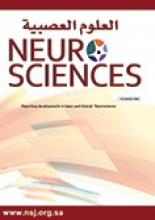Abstract
OBJECTIVE: To study the findings of magnetic resonance spectroscopy (MRS) of the brain in patients with sickle cell disease (SCD).
METHODS: This study was carried out from January 2007 to February 2009, in the Radiology Department of King Fahd Military Medical Complex, Dhahran, Kingdom of Saudi Arabia. The study consists of 22 patients with SCD ranging from 6-17 years, excluding those with a recent change in brain function. Twenty-two control subjects ranging from 7-19 years (13 boys, 9 girls) were also evaluated. An MRI and MRS were carried out for all patients.
RESULTS: Patients had a proportion of N-acetyl aspartate (NAA) in the basal ganglia that was higher than that of healthy control subjects. A higher ratio of NAA to choline (Cho) in patients compared to control subjects (p=0.012) was shown on short-echo and long-echo spectra (p=0.016). The ratio of Cho to creatine (Cr) was similar in patients and control subjects.
CONCLUSION: The NAA is strikingly increased in the brain spectra of children with SCD, with no recent brain insult, questioning what is known of it as an indicator of neuronal viability.
- Copyright: © Neurosciences
Neurosciences is an Open Access journal and articles published are distributed under the terms of the Creative Commons Attribution-NonCommercial License (CC BY-NC). Readers may copy, distribute, and display the work for non-commercial purposes with the proper citation of the original work.






